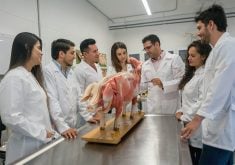HUMBOLDT, Sask. – Canada can’t tackle rural poverty until the farm income problem is resolved, a witness told the Senate standing committee on agriculture and forestry in Humboldt on March 8.
Germain Dauk, a pulse grower from Naicam, Sask., told the committee that he and his two sons who farm with him “are scrambling to obtain credit to seed this year’s crop. We are living on depreciation, off-farm income and my pensions. Rural poverty is a reality for many producers.”
In that, he had the agreement of at least one member of the committee, which held five meetings in Western Canada last week. Senator Len Gustafson said the price of a bushel of wheat and a barrel of oil were the same in 1970, but today wheat sells for $3 and oil for $58.
Read Also

Fuel rebate rule change will affect taxes and AgriStability
The federal government recently announced updates to the fuel rebates that farmers have been receiving since 2019-20.
During a break at the Humboldt hearing, the senator added that established farmers are using up their equity because they are not receiving their costs of production for grain and cattle. Meanwhile, younger farmers are in an even more desperate situation with little to keep them going.
Dauk confirmed that in his testimony, saying his sons said they’ll farm one more year and if the economics don’t turn around, they’re done.
“That’s the generation we’re losing and that concerns me,” Dauk said.
Added Gustafson: “It’s going to take an injection of cash to help out farmers.”
He and committee chair Joyce Fairbairn noted that their committee’s role is to make the public aware of rural poverty and pressure the government to do something about it. The committee is to make its final report this fall.
Dauk suggested solutions, starting with fixing the country’s risk management programs, which he called inadequate to deal with multi-year farm disasters. He also noted the importance of farmer participation in value-added ventures such as biofuel and nutraceutical food and possibly paying farmers for social benefits such as maintaining wetlands.
Other presenters outlined the positive effects of Community Futures corporations. These are volunteer economic and social development groups often funded by the federal government to kick start job development and innovative solutions to rural problems.
Dianne Olchowski of the Sagehill CF in Saskatchewan said her region is developing the spin-off benefits from the historic site at Batoche, the Manitou Lake spa and a proposed biodiesel facility at Nokomis, Sask. One hundred jobs had been vacant in the Sagehill area, she added, which is why one of their focuses is on young people.
“Kids need to leave to get an education, but we must encourage them to come back rather than harping on why they leave.”
Olchowski said in an interview that she hoped the senators would help the government deliver more effective services to rural areas.
“Governments have tended to do it one piece at a time. There is an agriculture policy and a water policy and a transportation policy.”
MidSask CF in Kenaston, Sask., is trying to do this by bringing international students to the community. They would not only raise rural school enrolment, but would also pay about $6,000 a year each in room and board to rural families.
Senators on the committee said they had heard of the success of residential rural schools such as the girls’ hockey school in Warner, Alta.
Innovative thinking is needed, agreed Russ McPherson, a MidSask member. The grain farmer said rural people are slow to change and he pointed to the need for more amalgamation of Saskatchewan’s 296 rural municipalities. The RMs have resisted that and McPherson said it’s natural to want to remain distinct. As well, taxpayers who live in a municipality that has oil or pipeline income don’t want to be joined to a poor one and have to pay more taxes.
However, McPherson noted when his grandfather was on the RM council in the 1930s, the municipality was responsible for a lot more than grading and gravelling roads. It also buried the poor and offered social services. He said as a councillor for the RM of Rudy, his views are not popular at SARM conventions. He will be at this week’s annual meeting of SARM and expects he will “eat alone in the cafeteria” again.
In an interview after his presentation, McPherson said the MidSask area has been working on a pilot program called WaterWolf to look at how municipalities can help each other, such as sharing water technicians, discussing zoning issues and developing a unified tax template.
Within the area there is more willingness to see a form of regional governance and provincially he sees more appetite for building a roads strategy because of the cost of fixing those pounded by grain trucks.
“You can’t do land use planning in isolation,” he said.
“Let’s get some commonality in rules, like no hog barns right on the edge of the river. In 50 years time I think people will live along rivers or in lake areas, not on the flat dry prairie. Can you attract them if you have a hog barn nearby?”
McPherson said young people will return to rural areas if they are offered good jobs rather than seasonal farm labour.
As the trend to larger farms continues, the Prairies will become emptier. As a result “we’re going to have to coalesce around regional centres,” he said.
“Let’s not pour concrete and build hospitals in a village with no future.”














